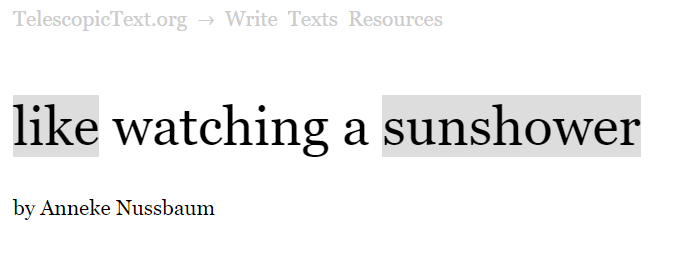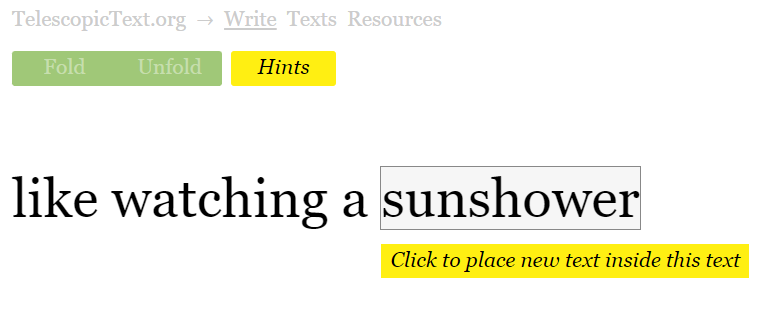I found an online tool for creating stretchtext hypertexts called TelescopicText (created in 2010 by Joe Davis) and spent some time playing around with it to check out its affordances. Since I was never truly satisfied with the resulting reader experience of my Twine e-poem “like watching a sunshower” (5.0 version) I thought I would see what this new tool could do to help me realize my vision.

The interface is quite simple. The user types the starting phrase into a text box and then selects words within the phrase to either change or expand on. The author has the choice to “fold” and “unfold” the text to preview the reader’s experience, can view the structure of the hyperlinks and can “empty” links of their contents to fix errors. This is a tool that I can see myself using with students in many ways. There is no coding at all needed, so the tool has a “low floor” (Burke and Kafai, 2014, p. 696) entry. While it doesn’t have a “high ceiling” (p. 697) or “wide walls” (p. 699) in terms of the depth and variety of texts one can create, it does help to visualize the possibilities of writing and expandable sentences. It also creates an interesting journey for the reader as the narrative is expanded from one small phrase into something much larger.


Due to the limitations of the program, I could not recreate my e-poem to match my vision as a reader created experience, as a kind of “creative reading”. The TelescopicText tool limits the writer to expanding a word in place, rather than appending a line to the end when clicking a word in the middle or beginning of the phrase. At the same time, I couldn’t create separate lines or stanzas. This “low ceilinged” and “narrow walled” nature of the tool means that it has limited application and puts very specific constraints on the writer. However, as a creative writing and composition teacher, I can see many applications of this tool to strengthen student writing:
- practicing “Show, Don’t Tell” writing techniques
- enhancing descriptive imagery
- writing stretchtext poetry
- writing a strechtext short narratives (personal or fictional)
- Imagine a writer’s workshop in which each student begins with the same phrase and then individually explores how they might expand that phrase into a paragraph (or more)
There is much to say about the positive impact of placing constraints on writers as a way to focus and challenge them, which is one of the compelling elements of e-literature authorship. While adapting my e-poem to this platform only took me a morning’s work, it’s important to note that the text was already both ideated as well as organized into links since I revisited my twine path structure to guide me in the hyperlinking. Interestingly, but not surprisingly, due to the constraints of the tool, my writing shifted. Since the text was no longer “creative reading” in the same sense as my twine original, and the lines couldn’t append in the order the reading chose, I shifted the diction and phrasing to emphasize the coming-of-age, loss of innocence theme underlying the nostalgia of my lines. As the reader traverses the text, there is a moving forward and backward (both figuratively and literally) as they experience what the author is re-experiencing about childhood from an adult perspective.
References
Burke, Q. and Kafai, Y. (2014). Decade of game making for learning: From tools to communities. M. Angelides & H. Agius (Eds.) Handbook of Digital Games (pp. 689-709). New York: John Wiley & Sons, Inc.
Davis, J. (2010, December 11). TelescopicText.org is live. Retrieved from https://www.telescopictext.org/resources/news/telescopictext-is-live


One thought on “Playing with Tools: Telescopic Text”